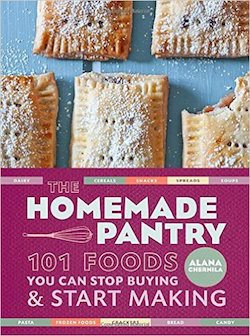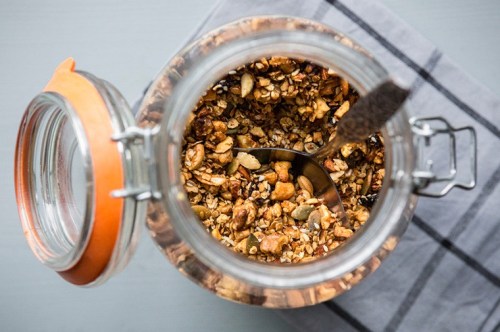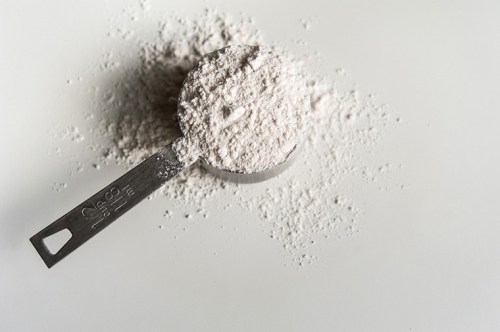Our editors independently select these products. Making a purchase through our links may earn Well+Good a commission
3 pantry hacks every healthy person should start doing
The Homemade Pantry author Alana Chernila gives three tips for cleaning your pantry and kitchen, without having anything go to waste.

Discovering the perfect recipe that uses an alt-flour blend or sweetening your brownies using only all-natural sources sometimes feels a bit too good to be true. And while it’s not—that healthy cookie dough recipe is no mirage—there is one unintended consequence of experimenting in the kitchen and leading a good-for-you lifestyle: clutter.

One recipe calls for buckwheat flour, while another uses coconut. Sometimes you reach for avocado oil, and other times you prefer grapeseed—or you make your own turmeric oil. And then there are all those things you’ve purchased on a whim (nutritional yeast, quinoa flakes, coconut shavings…) that you pull out once in a blue moon.
So what to do if you’ve only got so much room in your kitchen—or are ready to get a jump start on spring cleaning? The Homemade Pantry author Alana Chernila has mastered the art of a well-organized kitchen.
Scroll down for 3 easy ways to clear out your cabinets—without throwing everything in the garbage.

1. Make your own mixes
One way to start using everything you bought on a whim: combine ’em. “Granola is a really good place to start for people who don’t have a lot of experience making things at home,” Chernila says. “You can tailor it to what you like, and it will often be healthier than something store-bought.” Some examples of what you can throw together in a mason jar: nuts (any type works), grated coconut, chia seeds, quinoa flakes, cereal, cacao—go wild.
Chernila also likes to make her own spice blends. “First of all, I buy in bulk—those tiny sizes are pointless,” she says. Then, she starts combining them, like making a curry powder using cardamom, chili, and black peppercorn. Everything goes into her trusty mason jars and gets a label slapped on it.

2. Don’t be afraid to experiment with alt-flours
How to make sure you don’t end up with a bunch of bulky, half-used bags of flour? “First, I store all my flours in the freezer, which you should be doing anyway, because otherwise they go rancid,” Chernila says. Each one goes in a mason jar (yep, you’re going to have to stock up) and is labeled.
Her next tip: Start experimenting with those alt-flours hanging out at the back of your cabinet. “I like to make my own pancake mix, blending a few different types of flours together,” she says. “You can mix whole-grain flour with alt-flour. And buckwheat flour is really good in crepes.” (For some guidance, try this expert-approved gluten-free blend.)
If you have a surplus of just one type of flour and you aren’t sure what to do with it, Chernila suggests trying this kitchen lab experiment: Add half a cup to a dish, even if a recipe doesn’t call for it. “You start learning a lot about how different [flours] work and taste, which is really fun.”

3. Give everything its own special place
“I have shelves in my pantry, and everything is labeled. And all my teas are kept on a tray because typically when I’m making some, I’m offering someone else a cup as well, so that way I can bring out the tray and let him or her pick one out.” Genius, right?
When it comes to the fridge, Chernila’s husband came up with an easy way to make leftovers and meal-prepped foods more visible. “We use those glass containers with plastic tops and just flip them over—unless there’s liquid inside—so it’s easier to see what’s in them,” she says. The bottom line: If it isn’t visible, chances are it’s going to sit there and not get eaten.
If something is past the sell-by date? Don’t automatically throw it out, she says.
And if something is past the sell-by date? Don’t automatically throw it out, she says—it cuts down on food waste in a major way. “Using your eyes and nose is a much better indicator of when something has expired than what’s on the label,” she says.
When it comes to keeping your kitchen organized—and actually using what you buy—the key is not being afraid to experiment and mix it up (literally) in order to create extra pantry space, even in the tiniest kitchen. And who knows? You might make enough room to finally attempt #herbgardengoals greatness.
Once the pantry’s been checked off your spring-cleaning to-do list, check out these “cleaner” home products for the rest of the house. And if you don’t see your go-to brand on the list, here’s how to know if it’s toxic or not.
Sign Up for Our Daily Newsletter
Get all the latest in wellness, trends, food, fitness, beauty, and more delivered right to your inbox.
Got it, you've been added to our email list.










